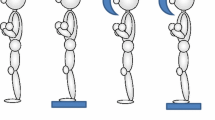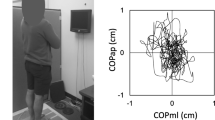Abstract
Background and aims: Postural stability is essential to the performance of most daily activities and is necessary to lead an independent lifestyle. Most functional assessments of balance have only evaluated spatial properties of posture, however, assessments should also evaluate balance in the temporal domain. Both domains provide crucial information to an individual’s postural stability. The following study examines time to regain stability and the magnitude of postural motion following a virtual perturbation. Methods: To examine the temporal limitations imposed by age (n=45),3 adult age groups were tested, young (18–19 yr), young old (60–69 yr), and old adults (70–79 yr). Participants were placed into a virtual room appearing as if the visual surround moved in a discrete antero-posterior motion. A force platform was used to assess postural motion across 4 visual perturbation conditions, 9 and 18 cm and 0.3 and 0.6 Hz. Results: Young adults exhibited significantly less postural motion than both of the older age groups and required the least amount of time to regain postural stability following the discrete visual perturbation, while the old adults required the greatest amount of time. Conclusions: These findings indicate that even small visual perturbations induce strong temporal limitations which are magnified by advancing age. Furthermore, the postural saturation (reduction in postural motion) that is typically found in young adults with increasing movement magnitude was not found in either of the older adult groups. Older adults are at a higher risk of losing balance during this period of time to reacquire postural stability which appears to be unaffected by elevated visual motion.
Similar content being viewed by others
References
Slobounov SM, Moss SA, Slobounova ES, Newell KM. Aging and time to instability in posture. J Gerontol 1998; 53A: B71–8.
Van Wegen EEH, Van Emmerik REA, Riccio GE. Postural orientation: Age-related changes in variability and time-to-boundary. Hum Mov Sci 2002; 21: 61–84.
Johnson C, Mihalko S, Newell K. Aging and the time needed to reacquire postural stability. J Aging Phys Act 2003; 11: 419–29.
Riccio GE. Information in movement variability. About the qualitative dynamics of posture and orientation. In Newell KM, Corcos DM, Eds. Variability and motor control. Champaign, IL: Human Kinetics Publishers, 1993.
Lee DN, Aronson E. Visual proprioceptive control of standing in human infants. Percept Psychophysiol 1974; 15: 529–32.
Stoffregen TA. Row structure versus retinal location in the optical control of stance. J Exp Psychol Hum Percept Perform 1985; 11: 554–65.
Stelmach G, Teasdale N, DiFabio RP. Age related decline in postural control mechanisms. Int J Aging and Hum Dev 1989; 29: 205.
Wade MG, Lindquist R, Taylor JR, Treat-Jacobson D. Optical flow, spatial orientation, and the control of posture in the elderly. J Gerontol 1995; 50B: P51–8.
Lee DN, Lishman JR. Visual proprioceptive control of stance. J Hum Mov Stud 1975; 1: 87–95.
Kuno S, Kawakita T, Kawakami O, Miyake Y, Watanabe S. Postural adjustment response to depth direction moving patterns produced by virtual reality graphics. Jpn J Physiol 1999; 49: 417–24.
Prioli AC, Freitas Junior PB, Barela JA. Postural control in active and sedentary elderlies. Gerontology 2005; 51: 145–8.
Tossavainen T, Juhola M, Aalto H, et al. Postural control as assessed with virtual reality. Acta Otolaryngol 2001; 545: 53–6.
Tossavainen T, Juhola I, Pyykkö I, Aalto E, Toppila G. Virtual reality stimuli for force platform posturography. In Surján G, Engelbrect R, McNair P, eds. Proceedings of MIE 2002. Amsterdam: IOS Press, 2002: 78–82.
Tossavainen T, Juhola R, Pyykkö I, Aalto H, Toppila E. Development of virtual reality stimuli for force platform posturography. Int J Med Inform 2003; 70: 277–83.
O’Loughlin JL, Robitaille Y, Boivin JF, Suissa S. Incidence of and risk factors for falls and injurious falls among the community-dwelling elderly. Am J Epidemiol 1993; 137: 342–54.
Mergner T, Schweigart G, Maurer C, Blümle A. Human postural responses to motion of real and virtual visual environments under different support base conditions. Exp Brain Res 2005; 167: 535–56.
Spirduso WW, Francis DL, MacRae PG. Physical dimensions of aging, 2nd ed. Champaign, Illinois: Human Kinetics, 2005: 131–51.
Rosenhall U, Rubin W. Degenerative changes in the human vestibular sensory epithelia. Acta Otolaryngol 1975; 79: 67–81.
Van Asten WN, Gielen CC, Denier van der Gon JJ. Postural movements induced by rotations of visual scenes. J Opt Soc Am 1988; 5: 1781–9.
Peterka RJ, Benolken MS. Role of somatosensory and vestibular cues in attenuating visually induced human postural sway. Exp Brain Res 1995; 105: 101–10.
Oie KS, Kiemel T, Jeka JJ. Human multisensory fusion of vision and touch: detecting non-linearity with small changes in the sensory environment. Neurosci Lett 2001; 315: 113–6.
Sekuler R, Sekuler AB. Visual perception and cognition. In Evans JG, Williams TF, ed. Oxford textbook of geriatric medicine. Oxford: Oxford University Press, 1992: 575–9.
Author information
Authors and Affiliations
Corresponding author
Rights and permissions
About this article
Cite this article
Haibach, P.S., Slobounov, S.M., Slobounova, E.S. et al. Aging and time-to-postural stability following a visual perturbation. Aging Clin Exp Res 19, 438–443 (2007). https://doi.org/10.1007/BF03324728
Received:
Accepted:
Published:
Issue Date:
DOI: https://doi.org/10.1007/BF03324728




